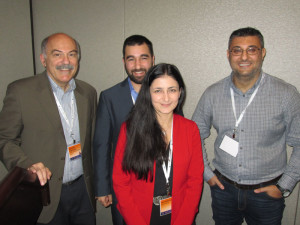Society for Armenian Studies Holds 42nd Annual Meeting in Boston

Left to right: Barlow Der Mugrdechian, Varak Ketsamanian, Anna Aleksanyan, and Ümit Kurt.
The Society for Armenian Studies (SAS) held its 42nd Annual Meeting in Boston, Massachusetts on Thursday, November 17, 2016.
Scholars from throughout the United States and abroad participated in the Annual Meeting, which was held in conjunction with the Middle East Studies Association Annual Conference.
SAS President Barlow Der Mugrdechian welcomed members to the Annual Meeting, which was held immediately following the SAS organized conference on “Armenians in America.”
Der Mugrdechian announced that Khatchig Mouradian and Vahe Sahakyan were elected to the SAS Executive Council for 2017. Outgoing Executive Council member Bedross Der Matossian was thanked for his many years of service on the Executive Council. The new Executive Council for 2017 is comprised of President, Barlow Der Mugrdechian; Vice-President Vartan Matiossian; Treasurer, Sergio La Porta; Secretary, Khatchig Mouradian, and advisors Lilit Keshishyan, Vahe Sahakyan, and Arpi Siyahian.
Reports were given on SAS publications such as the SAS Newsletter and the peer reviewed Journal of the Society for Armenian Studies (JSAS). JSAS Editor Sergio La Porta reported that JSAS Volume 24 (2015) had been published and that JSAS Volume 25 (2016) is in production. The Society expressed its appreciation to the Dolores Zohrab Liebmann Fund for its annual subvention of the JSAS.
Der Mugrdechian reported that the SAS had gained four regular members and seven student members for the year. Graduate students who participate in conferences are eligible to become student members without having to pay dues their first year as members.
In 2016 SAS cosponsored the February 12 UCLA Graduate Student Colloquium in Armenian Studies; the March 18-19 conference, “Empire, Politics, and War: The Armenian Genocide within the Context of the Ottoman Empire” with the Armenian Studies Program at California State University, Fresno; and the April 8 Mediterranean Seminar on “Politics, Identity, and Religion” at California State University, Fresno. It also organized a round-table with the Ottoman Turkish Studies Association on “Knowledge Production, Exclusion, Inclusion: The Repositioning of Armenians in Ottoman and Turkish Historiography” at the Middle East Studies Association (MESA) Annual Conference.
The SAS Executive Council presented plans to establish a permanent endowment to benefit the Society’s activities. They also plan to circulate a survey of members to develop future plans for the Society.
The meeting concluded with an open discussion among members concerning a variety of issues.
The SAS and the National Association for Armenian Studies and Research (NAASR) cosponsored a reception at NAASR’s Belmont headquarters on Friday, November 18. SAS members and NAASR Leadership Council members attended the reception and heard brief remarks about future plans from leaders of the respective organizations. Scholars introduced themselves and discussed their research interests.
The SAS sponsored a panel on “New Issues, Perspectives and Sources in Armenian Studies” at the 2016 MESA Conference, chaired by Barlow Der Mugrdechian (California State University, Fresno), with the participation of Varak Ketsamanian (Princeton University), Anna Aleksanyan (Clark University), discussant Ümit Kurt (Post-doctoral fellow at Harvard University).
Ketsamanian’s paper on “The Hunchakian Revolutionary Party from 1891-1895” focused on the precursors to the Sassoon massacre of 1894, utilizing a micro-historical approach. The role of the Hunchakian party in the period of 1891-1893 is crucial to an understanding of the events in Sassoon.
Anna Aleksanyan’s presentation on “Ritualized Rapes and Body Destruction of the Armenian Women during the Genocide,” analyzed the role that rape played during the Armenian Genocide. She also discussed comparative cases, for example in the former Yugoslavia, where rape was also a systematic part of the violence.
Ümit Kurt was the discussant for the panel and delineated the major changes in genocide studies in the last few years, especially reflecting on new evidence that has been recently published and the growing number of young scholars in the field.
Among the important points he made is that many new scholars are using and testing fresh theories, such as the contrast between the periphery (the provinces) versus the center (the Ottoman capital of Istanbul). What was happening on the ground and what role local actors had in the Genocide has long been under studied.
Kurt also emphasized the significance of uncovering new primary sources, especially Armenian ones, to supplement knowledge of the Genocide.
The Society for Armenian Studies 2017 Annual Meeting will be held on Saturday, November 18 at the Marriott Wardman Park Hotel in Washington, D. C.







